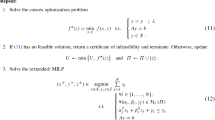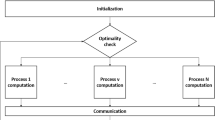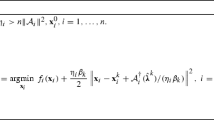Abstract
This paper presents the distributed primal outer approximation (DiPOA) algorithm for solving sparse convex programming (SCP) problems with separable structures, efficiently, and in a decentralized manner. The DiPOA algorithm development consists of embedding the recently proposed relaxed hybrid alternating direction method of multipliers (RH-ADMM) algorithm into the outer approximation (OA) algorithm. We also propose two main improvements to control the quality and the number of cutting planes that approximate nonlinear functions. In particular, the RH-ADMM algorithm acts as a distributed numerical engine inside the DiPOA algorithm. DiPOA takes advantage of the multi-core architecture of modern processors to speed up optimization algorithms. The proposed distributed algorithm makes practical the solution of SCP in learning and control problems from the application side. This paper concludes with a performance analysis of DiPOA for the distributed sparse logistic regression and quadratically constrained optimization problems. Finally, the paper concludes with a numerical comparison with state-of-the-art optimization solvers.






Similar content being viewed by others
Notes
A polytope is a bounded polyhedron [16, Chapter 2, pg. 31].
The problems are different in the sense that the problem data are not necessarily the same.
Abbreviations
- CN:
-
Communication Network
- DiPOA:
-
Distributed primal outer approximation
- D-MILP:
-
Distributed mixed integer linear program
- D-NLP:
-
Distributed nonlinear program
- D-MINLP:
-
Distributed MINLP
- DSLR:
-
Distributed sparse logistic regression
- ET-SoCut:
-
Event triggered SoCut
- GBD:
-
Generalized benders decomposition
- LFC:
-
Local fusion center
- MIP:
-
Mixed integer programming
- MPI:
-
Message passing interface
- MINLP:
-
Mixed integer nonlinear program
- MILP:
-
Mixed integer linear program
- MIQP:
-
Mixed integer quadratic program
- MIQCP:
-
Mixed integer quadratically constrained program
- NLP:
-
Nonlinear programming
- OA:
-
Outer approximation
- RH-ADMM:
-
Relaxed-hybrid alternating direction method of multipliers
- SCP:
-
Sparse convex programming
- SLR:
-
Sparse logistic regression
- SoCut:
-
Second order cut
- SQCQP:
-
Sparse quadratically constrained quadratic programming
References
Aguilera, R.P., Urrutia, G., Delgado, R.A., Dolz, D., Agüero, J.C.: Quadratic model predictive control including input cardinality constraints. IEEE Trans. Autom. Control 62(6), 3068–3075 (2017). https://doi.org/10.1109/TAC.2017.2674185
Aytug, H.: Feature selection for support vector machines using generalized benders decomposition. Eur. J. Oper. Res. 244(1), 210–218 (2015). https://doi.org/10.1016/j.ejor.2015.01.006
Bai, Y., Liang, R., Yang, Z.: Splitting augmented Lagrangian method for optimization problems with a cardinality constraint and semicontinuous variables. Optim. Methods Softw. 31(5), 1089–1109 (2016). https://doi.org/10.1080/10556788.2016.1196206
Bernal, D.E., Vigerske, S., Trespalacios, F., Grossmann, I.E.: Improving the performance of DICOPT in convex MINLP problems using a feasibility pump. Optim. Methods Softw. 35(1), 171–190 (2020). https://doi.org/10.1080/10556788.2019.1641498
Bertsimas, D., Cory-Wright, R.: A scalable algorithm for sparse portfolio selection. INFORMS J. Comput. (2022). https://doi.org/10.1287/ijoc.2021.1127
Bertsimas, D., Dunn, J.: Machine learning under a modern optimization lens. Dyn. Ideas LLC (2019)
Bertsimas, D., King, A.: Best subset selection via a modern optimization lens. Ann. Stat. 44(2), 813–852 (2016). https://doi.org/10.1214/15-AOS1388
Bertsimas, D., King, A.: Logistic regression: From art to science. Stat. Sci. 32(3), 367–384 (2017). https://doi.org/10.1214/16-STS602
Bertsimas, D., Mundru, N.: Sparse convex regression. INFORMS J. Comput. 33(1), 262–279 (2021). https://doi.org/10.1287/ijoc.2020.0954
Bertsimas, D., Pauphilet, J., Parys, B.V.: Sparse classification: a scalable discrete optimization perspective. Mach. Learn. 110(October) (2021). https://doi.org/10.1007/s10994-021-06085-5
Bertsimas, D., Shioda, R.: Algorithm for cardinality-constrained quadratic optimization. Comput. Optim. Appl. 43(1), 1–22 (2009). https://doi.org/10.1007/s10589-007-9126-9
Bienstock, D.: Computational study of a family of mixed-integer quadratic programming problems. Math. Program. 74(2), 121–140 (1996). https://doi.org/10.1007/BF02592208
Blumensath, T.: Compressed sensing with nonlinear observations and related nonlinear optimization problems. IEEE Trans. Inf. Theory 59(6), 3466–3474 (2013). https://doi.org/10.1109/TIT.2013.2245716
Blumensath, T., Davies, M.E.: Iterative hard thresholding for compressed sensing. Appl. Comput. Harmon. Anal. 27(3), 265–274 (2009). https://doi.org/10.1016/j.acha.2009.04.002
Bourguignon, S., Ninin, J., Carfantan, H., Mongeau, M.: Exact sparse approximation problems via mixed-integer programming: Formulations and computational performance. IEEE Trans. Signal Process. 64(6), 1405–1419 (2015). https://doi.org/10.1109/TSP.2015.2496367
Boyd, S., Boyd, S.P., Vandenberghe, L.: Convex Optimization. Cambridge university press, Cambridge (2004)
Boyd, S., Parikh, N., Chu, E., Peleato, B., Eckstein, J., et al.: Distributed optimization and statistical learning via the alternating direction method of multipliers. Foundations and Trends® in Machine Learning 3(1), 1–122 (2011). https://doi.org/10.1561/2200000016
Candès, E.J.: The restricted isometry property and its implications for compressed sensing. C.R. Math. 346(9–10), 589–592 (2008). https://doi.org/10.1016/j.crma.2008.03.014
Duran, M.A., Grossmann, I.E.: An outer-approximation algorithm for a class of mixed-integer nonlinear programs. Math. Program. 36(3), 307–339 (1986). https://doi.org/10.1007/BF02592064
Fletcher, R., Ley, S.: Solving mixed integer nonlinear programs by outer approximation. Math. Program. 66, 327–349 (1994). https://doi.org/10.1007/BF01581153
Geoffrion, A.M.: Generalized benders decomposition. J. Optim. Theory Appl. 10(4), 237–260 (1972). https://doi.org/10.1007/BF00934810
Gropp, W., Lusk, E., Skjellum, A.: Using MPI: Portable Parallel Programming with the Message-Passing Interface. MIT Press, Cambridge (2014)
Grossmann, I.: Review of nonlinear mixed-integer and disjunctive programming techniques. Optim. Eng. 3(3), 227–252 (2002). https://doi.org/10.1023/A:1021039126272
Gurobi Optimization, L.: Gurobi optimizer reference manual (2020). http://www.gurobi.com
Hastie, T., Tibshirani, R., Tibshirani, R.: Best subset, forward stepwise or lasso? Analysis and recommendations based on extensive comparisons. Stat. Sci. 35(4), 579–592 (2020). https://doi.org/10.1214/19-STS733
Hijazi, H., Bonami, P., Cornuéjols, G., Ouorou, A.: Mixed-integer nonlinear programs featuring on/off constraints. Comput. Optim. Appl. 52(2), 537–558 (2012). https://doi.org/10.1007/s10589-011-9424-0
James, G., Witten, D., Hastie, T., Tibshirani, R.: An Introduction to Statistical Learning. Springer, Berlin (2013)
Kamiya, S., Miyashiro, R., Takano, Y.: Feature subset selection for the multinomial logit model via mixed-integer optimization. In: the 22nd International Conference on Artificial Intelligence and Statistics, pp. 1254–1263. PMLR (2019)
Kronqvist, J., Bernal, D.E., Grossmann, I.E.: Using regularization and second order information in outer approximation for convex MINLP. Math. Program. 180(1–2), 285–310 (2020). https://doi.org/10.1007/s10107-018-1356-3
Kronqvist, J., Bernal, D.E., Lundell, A., Grossmann, I.E.: review and comparison of solvers for convex MINLP. Optim. Eng. 20(2), 397–455 (2019). https://doi.org/10.1007/s11081-018-9411-8
Kronqvist, J., Lundell, A., Westerlund, T.: The extended supporting hyperplane algorithm for convex mixed-integer nonlinear programming. J. Global Optim. 64(2), 249–272 (2016). https://doi.org/10.1007/s10898-015-0322-3
Kronqvist, J., Lundell, A., Westerlund, T.: Reformulations for utilizing separability when solving convex MINLP problems. J. Global Optim. 71(3), 571–592 (2018). https://doi.org/10.1007/s10898-018-0616-3
Lundell, A., Kronqvist, J.: Integration of polyhedral outer approximation algorithms with MIP solvers through callbacks and lazy constraints. In: AIP Conference Proceedings 2070(March) (2019). https://doi.org/10.1063/1.5089979
Ma, M., Nikolakopoulos, A.N., Giannakis, G.B.: Hybrid admm: a unifying and fast approach to decentralized optimization. EURASIP J. Adv. Signal Process. 2018(1), 1–17 (2018). https://doi.org/10.1186/s13634-018-0589-x
Murray, A., Faulwasser, T., Hagenmeyer, V., Villanueva, M.E., Houska, B.: Partially distributed outer approximation. J. Global Optim. 80, 523–550 (2021). https://doi.org/10.1007/s10898-021-01015-0
Muts, P., Nowak, I., Hendrix, E.M.: The decomposition-based outer approximation algorithm for convex mixed-integer nonlinear programming. J. Global Optim. 77, 75–96 (2020). https://doi.org/10.1007/s10898-020-00888-x
Nedić, A., Liu, J.: Distributed optimization for control. Ann. Rev. Control Robot. Autonom. Syst. 1, 77–103 (2018). https://doi.org/10.1146/annurev-control-060117-105131
Nedić, A., Olshevsky, A.: Distributed optimization over time-varying directed graphs. IEEE Trans. Autom. Control 60(3), 601–615 (2015). https://doi.org/10.1109/TAC.2014.2364096
Notarstefano, G., Notarnicola, I., Camisa, A., et al.: Distributed optimization for smart cyber-physical networks. Found. Trends® Syst. Control 7(3), 253–383 (2019). https://doi.org/10.1561/2600000020
Olama, A., Bastianello, N., Mendes, P.R., Camponogara, E.: Relaxed hybrid consensus ADMM for distributed convex optimisation with coupling constraints. IET Control Theory Appl. 13(17), 2828–2837 (2019). https://doi.org/10.1049/iet-cta.2018.6260
Ryu, E.K., Boyd, S.: Primer on monotone operator methods. Appl. Comput. Math 15(1), 3–43 (2016)
Sant’Anna, L.R., de Oliveira, A.D., Filomena, T.P., Caldeira, J.F.: Solving the index tracking problem based on a convex reformulation for cointegration. Financ. Res. Lett. 37, 101356 (2020). https://doi.org/10.1016/j.frl.2019.101356
Su, L., Tang, L., Bernal, D.E., Grossmann, I.E.: Improved quadratic cuts for convex mixed-integer nonlinear programs. Comput. Chem. Eng. 109, 77–95 (2018). https://doi.org/10.1016/j.compchemeng.2017.10.011
Su, L., Tang, L., Grossmann, I.E.: Computational strategies for improved MINLP algorithms. Comput. Chem. Eng. 75, 40–48 (2015). https://doi.org/10.1016/j.compchemeng.2015.01.015
Sun, X., Zheng, X., Li, D.: Recent advances in mathematical programming with semi-continuous variables and cardinality constraint. J. Oper. Res. Soc. China 1(1), 55–77 (2013). https://doi.org/10.1007/s40305-013-0004-0
Tibshirani, R.: Regression shrinkage and selection via the lasso. J. R. Stat. Soc.: Ser. B (Methodol.) 58(1), 267–288 (1996). https://doi.org/10.1111/j.2517-6161.1996.tb02080.x
Tillmann, A.M., Bienstock, D., Lodi, A., Schwartz, A.: Cardinality minimization, constraints, and regularization: a survey. arXiv preprint arXiv:2106.09606 (2021)
Wang, F., Cao, L.: A new algorithm for quadratic integer programming problems with cardinality constraint. Jpn. J. Ind. Appl. Math. 37, 449–460 (2020). https://doi.org/10.1007/s13160-019-00403-0
Westerlund, T., Pettersson, F.: An extended cutting plane method for solving convex MINLP problems. Comput. Chem. Eng. 19, 131–136 (1995). https://doi.org/10.1016/0098-1354(95)87027-X
Funding
This work was funded in part by Fundação de Amparo à Pesquisa e Inovação do Estado de Santa Catarina (FAPESC) under Grant 2021TR2265 and Coordenação de Aperfeiçoamento de Pessoal de Nível Superior (CAPES, Brazil) under the project PrInt CAPES-UFSC 698503P1.
Author information
Authors and Affiliations
Corresponding author
Ethics declarations
Competing interests
The authors declare that they have no conflict of interest.
Additional information
Publisher's Note
Springer Nature remains neutral with regard to jurisdictional claims in published maps and institutional affiliations.
Rights and permissions
Springer Nature or its licensor (e.g. a society or other partner) holds exclusive rights to this article under a publishing agreement with the author(s) or other rightsholder(s); author self-archiving of the accepted manuscript version of this article is solely governed by the terms of such publishing agreement and applicable law.
About this article
Cite this article
Olama, A., Camponogara, E. & Mendes, P.R.C. Distributed primal outer approximation algorithm for sparse convex programming with separable structures. J Glob Optim 86, 637–670 (2023). https://doi.org/10.1007/s10898-022-01266-5
Received:
Accepted:
Published:
Issue Date:
DOI: https://doi.org/10.1007/s10898-022-01266-5




